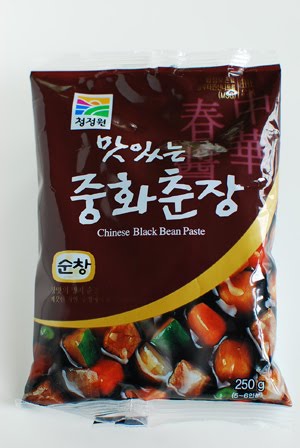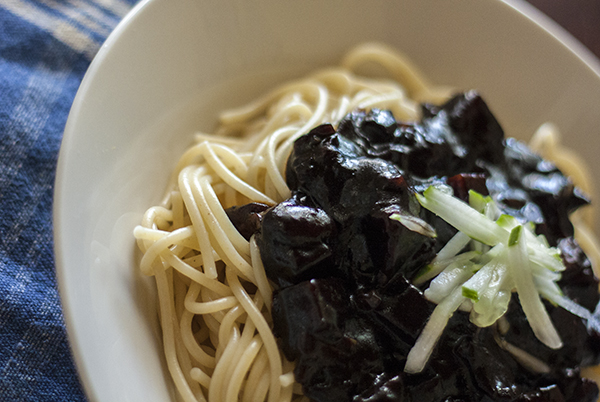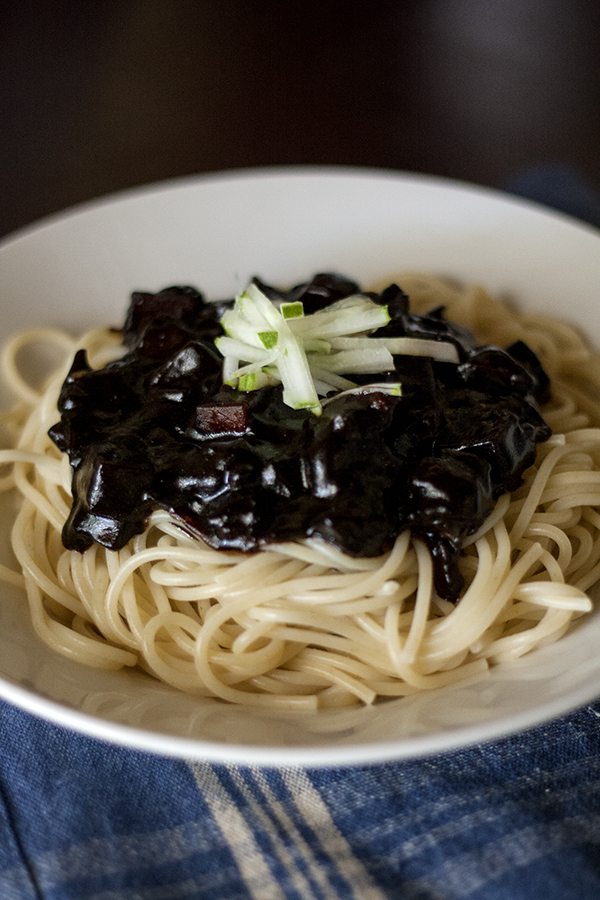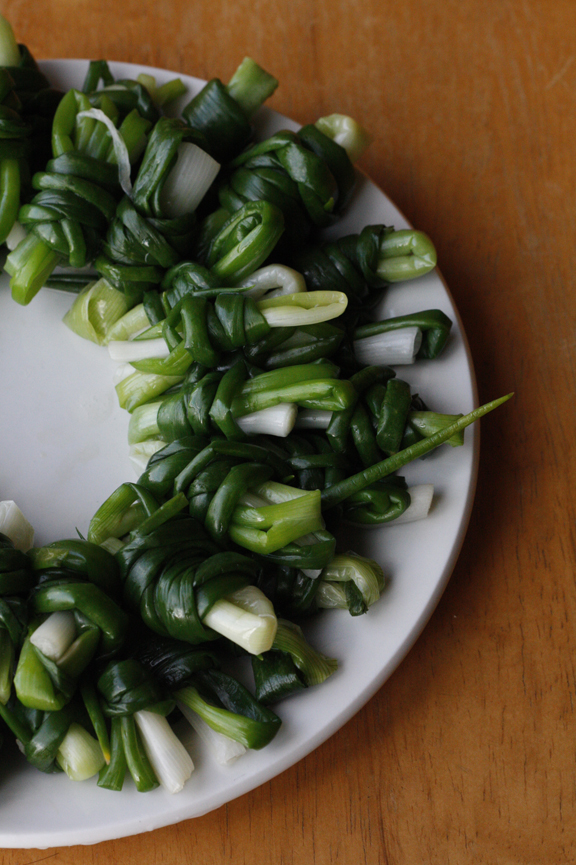I have to confess that I ate my very first bowl of jjajangmyeon (ìžìž¥ë©´) in Grenada. My Korean friend Terry (remember, she’s the one who likes to make things like tofu, miso, and kimchi from scratch!) invited me over for lunch one day and to my surprise and delight, she presented me with an overflowing bowl of noodles covered in sweet black bean sauce. And of course, there was a side of danmuji (yellow, pickled radish) to go along with it too.
Jjajangmyeon is originally a Chinese noodle dish (zhajiangmian 炸酱é¢) with regional variations in China. The most widely known is probably the Beijing version, which is made with a salty yellow soybean paste called huangdoujiang or simply huangjiang. In other areas of China, it is also made with doubanjiang (a fermented broad bean sauce common in Sichuan), hoisin sauce, or a sweet bean sauce called tianmianjiang.
When Chinese immigrants first started working in Incheon, Korea, they missed the flavors of home so much that they brought bean paste with them to make Chinese zhajiangmian. The Koreans picked up on this business opportunity quickly and soon began selling their own version of the bean paste, called chunjang, which is made by combining roasted soybean paste with a caramel base. It seems to be most similar to the Chinese tianmianjiang.
I prefer the Korean version of this dish to the Chinese version because I think the sweetness balances out the bitterness of the black beans nicely. To make the Korean version, I use a Korean “Chinese black bean paste” from HMart, with caramel included in its contents. The consistency is a bit more liquid than many other types of bean pastes.
Jjajangmyeon is typically served with wheat noodles, which you can find fresh or dried at Asian grocery stores. If those aren’t available, spaghetti works fine too! The vegetables in this dish can vary based on what’s in season but usually consist of potato cubes, zucchini, and in the Korean version, onions (which add sweetness). In Grenada, I substitute with cabbage because some of the other vegetables are hard to find. Traditionally, pork belly is used because the rendered fat is what is used to “fry” the sauce, but you can also use lean pork and vegetable oil as a healthier alternative. Incidentally, this treatment of the sauce is what gives this dish its name — literally, “fried sauce noodles” in both Korean and Chinese.
Here’s Terry’s basic recipe for jjajangmyeon. The only change I made was to cut the amount of oil in half to make it a bit healthier. I hope you enjoy it as much as I did!
Jjajangmyeon
4 servings
1/2 lb. pork belly (or lean pork)
1/2 cup sweet black bean paste (also known as chunjang in Korean and tianmianjiang in Chinese — look for caramel in the ingredients and a thin consistency)
1/4 c. fat rendered from pork belly and/or vegetable oil
2 1/2 Tbsp. sugar
2 1/2 Tbsp. oyster sauce
1 large potato
1 onion
1/3 head of cabbage (about 1 c. chopped), or substitute zucchini or daikon
2 cup chicken stock
2 Tbsp. corn starch
1/4 cup water
1 16 oz. pack of wheat or spaghetti noodles
cucumber matchsticks for garnish
1. Dice the pork belly, potatoes, onions, and cabbage (or zuchhini or daikon) into 1/2″ cubes.
2. In a large wok, fry the pork belly with 2 Tbsp. of vegetable oil until the pork is cooked and crispy.
3. Separate the pork belly and the fat/oil.
4. Add vegetable oil to the rendered pork fat until you have 1/4 cup. Put back into the wok.
5. Pour the black bean paste into the oil and fry for about 10 minutes, stirring constantly.
6. Meanwhile, start boiling water for your noodles. Prepare according to the package directions. Noodles can be a little softer than al dente for jjajangmyeon. Drain noodles when done and set aside.
7. After about 10 minutes, the sauce should look thinner and smoother. Half of the oil will still be separated from the sauce, but that’s okay. Pour out the sauce and put the excess oil back into the wok.
8. Begin stir-frying the vegetables in the wok with the oil, beginning with the potatoes. Add in the onions and cabbage (or zucchini or daikon) after about 2-3 minutes. Lastly, add in the pork.
9. Pour the fried paste into the vegetable and pork mixture, stir until coated evenly.
10. Add in the chicken stock and bring to a low simmer. Cook for about 10 minutes.
11. After 10 minutes, check to see if the potatoes are cooked. They should be just cooked through and still feel a bit firm.
12. Add in the corn starch, dissolved in water. Stir the sauce until thickened.
13. Season with additional salt and sugar as needed.
14. Serve over bed of noodles. Garnish with cucumber matchsticks. Enjoy!
































Connect with us